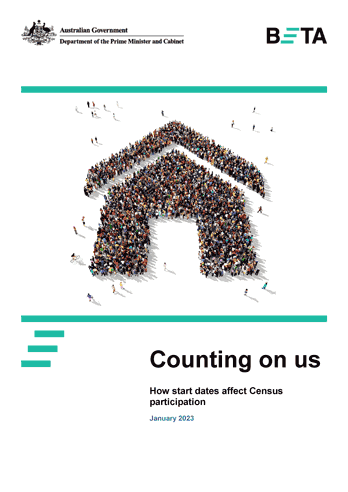The Census is the most comprehensive data collection in Australia. To encourage participation, the Australian Bureau of Statistics (ABS) moved away from a single 'Census Night'. Instead, in 2021, people had a number of days – or a 'response window' - to complete the Census.
Prior to making this change, the ABS partnered with BETA to redesign the Census letter and test two ways of presenting the response window to the public. The first version of the letter included a response window of one week ('complete between 11 and 17 October'). The second version had an immediate response window ('complete between now and 17 October'. We used a randomised controlled trial, embedded within a Census Test, to measure the impact of the two response windows.
The proportion of households commencing and completing the Census Test was similar regardless of which response window they saw. There was, however, a difference in when households commenced and completed their survey.
- Those who received the 'complete now' letter were more likely to commence the Census Test sooner. This effectively spread responses out over a longer period, reducing the administrative burden associated with collecting many responses on a single night
- Those who received the 'complete between' letter were more likely to respond on, or just after, the Census Test Night
ADDITIONAL TRIAL INFORMATION
Trial start and end dates: 8 October 2019 – 31 October 2019
Ethics approval: BETA ETH2019-02
Experimental design including randomisation: A cluster randomised trial. Clusters were small statistical areas called mesh blocks that consist of approximately 30 dwellings. Mesh blocks were stratified by: the difficulty of enumeration in the 2016 Census, number of dwellings, enumeration mode in 2016 Census (drop-off or mail-out), and mesh block category (e.g. residential, primary production). Mesh blocks were selected from strata in groups of four and randomly allocated to a treatment group on a one-to-one ratio.
Intervention: The intervention consisted of two versions of the invitation letter (delivered by post), each specifying a different window of time in which to complete the Census Test. One response window specified a closed response window of one week ('between 11 and 17 October', while the other specified an immediate response window ('between now and 17 October').
Control condition: N/A.
Outcome: The primary outcome was proportion of households that commenced the survey prior to October 18 (i.e. up to and including October 17). The secondary outcome was proportion of households that completed the survey prior to October 18 (i.e. up to and including October 17).
Sample size: Participants were residents in Wagga Wagga (NSW) and Logan (QLD). The expected sample size was 28,544 households from 892 mesh blocks (approximately 446 per treatment group). The actual sample size was 26,329 households.
Other: This trial was publicly pre-registered on the AEA registry, record number AEARCTR-0004984.


